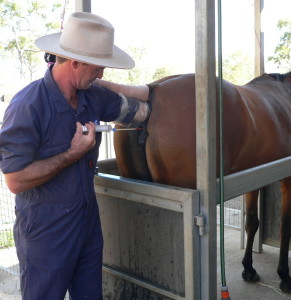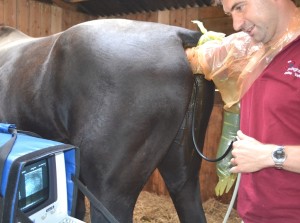 By Lyle Barbour
By Lyle Barbour
South Mountain Equine
Many questions arise when we begin to think about breeding a mare.
To begin, we want some baseline knowledge of the equine reproductive cycle. This allows us to understand the nuances of breeding. A mare’s cycle is consistent of a two-week period in which she is not in active “heat.” This period is called the diestrus stage. After this two-week period, the mare will begin to show signs of heat. Signs such as posturing to urinate frequently, behavioral changes which may be positive in nature or sometimes negative in nature begin to arise. Some mares will not be obvious as to whether they are in heat or not. This period is known to be roughly one week long in which ovulation occurs roughly on the sixth day. This period is known as estrous.
So, the total cycle length is three weeks and of which only one week the mare will be in act ive “heat.”
ive “heat.”
The cycle starts all over again after the one-week estrous period. Your mare ovulates roughly every 21 days and unless certain hormones are used, she will be bred to that time frame as well.
When breeding your mare a few things have to be thought through. The first thing to decide is which stallion you want to breed to. Does this require shipment from another state or is the stallion local?
Once you have decided on a stallion, you then need to decide when you would like to have a foal next year. Many people want a
foal as early in the calendar year as possible and others want to have a foal in the warmer months such as in the spring or summer.
Once these two questions have been answered then it is time to get your mare examined by your veterinarian. A rectal ultrasound will give you a good indication of what part of the cycle your mare is in and if any abnormalities are noticed. Your veterinarian may want further diagnostics to evaluate the health of the uterus.
Once your mare has been evaluated and we are ready to begin the breeding process, your veterinarian will try to acquire semen (shipped or local pickup) close to the ovulation period of your mare. The breeding process itself is relatively simple in that the semen is infused through a long pipette into the mares uterus.
Once this occurs your veterinarian will ultrasound the uterus to positively identify the fetus at around days 14-17 post ovulation. If she is confirmed pregnant, then subsequent rechecks will likely be done on days 45 and 90. If she is not pregnant at those times, she should be showing signs of heat at this time and semen shipment can be ordered according to her suspected
ovulation date.
If all goes as planned and she is confirmed pregnant, there are certain vaccinations that will need to be given to help decrease the chances of abortion. These are given on months 5, 7, and 9 of pregnancy and these dates should be marked on your calendar to ensure they are given at the proper time.
You will certainly want to consult with your veterinarian regarding the preparations you need to make for foaling and any post-foaling evaluations that need to be done.


It’s amazing that we can are able to perform ultrasounds on horses. I’m happy we can do ultrasounds on mares, especially when they are breeding and pregnant. When I have horses, I will make sure to remember to have consultations with my veterinarian in preparing for my mare giving birth.